Sailing With A Baby – The Ultimate Guide By A Sailing Family
Thinking of taking your baby sailing with you?
We imagine you’re here because you’re thinking about sailing with a baby. Perhaps wondering how safe it is? Is it possible? What should you take with you? These are the same questions most first time parents usually ask themselves however, now with an extra challenge – a boat! It might be that you’re keen on your first family holiday. Or, are looking to swap your land life for one on the open sea. Whichever it is, we want to let you know that sailing with a baby and small children is immense fun!
We’re a sailing family of four from Hamble that have been sailing with our young kids since they were babies. Carl works as a yacht captain, so it was inevitable that our boys would spend time around sail boats. We don’t live aboard full-time, however, we do sail regularly. And we have some great tips on sailing with a baby and as a family sailing.
We’ve got safety tips, a list of essential equipment and loads of advice to help get you ready to go sailing with your baby!
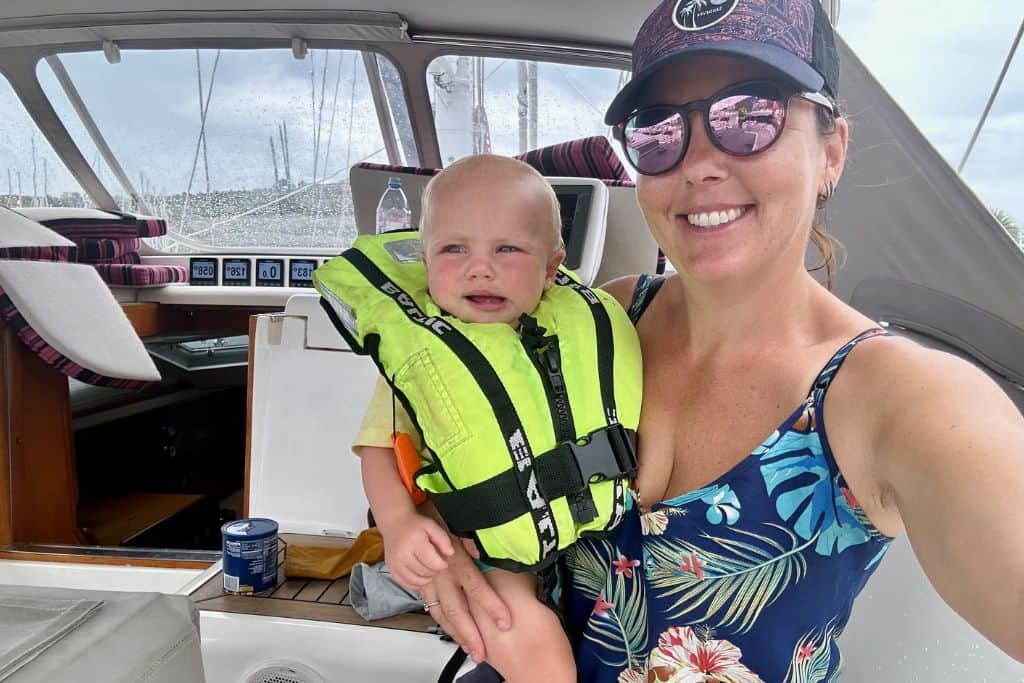
Can you take a baby on board a sailing boat with you?
Let’s get straight to the point – yes, you totally can take a new baby sailing with you. Whether this is your first baby, or your third, the main advice for any new parent is to make sure that you have a happy child living in a safe place. It will take a little extra planning and a few extra purchases to ensure they’ll be happy and safe. You’ll want to have a plan about where you’ll stay. You can either choose to use marinas or spend the night at anchor. Either way, we’re sure you’ll have a blast!
You only need to wander along a bustling quay or meet sailing families online to discover that babies don’t have to change the sailing plans that you have. Sailing with kids is a little like camping with kids. As both are totally possible, but just take that extra bit of planning.
You’ll want it to be smooth sailing (excuse the pun) and we’re here to give you advice on sailing with a new baby and small children.
How to keep a baby safe when you go sailing with them
The most important thing to think about when you’re sailing with either kids or babies is their safety.
As with any new adventure, there will always be people who will say that an activity is not safe for babies or small children. And we understand why because from the shore and without having tried it, sailing with a baby does seem like a bit of a crazy idea. Just having your first baby is complex enough with lots of safety advice on topics such as sleeping and feeding. However, then through in the fact that you’ll be surrounded by water and suddenly things seem a lot more risky.
If you make sure to take a few common precautions, as you’d do with something like buying a car seat, then sailing with a kids or a baby shouldn’t be, dangerous.
Here are some of the things that we’d advise you to do so that you keep your baby safe as you sail. Each tip depends a bit on the age of the baby, the boat, as well as where you’ll be sailing.
Life jackets and tethers
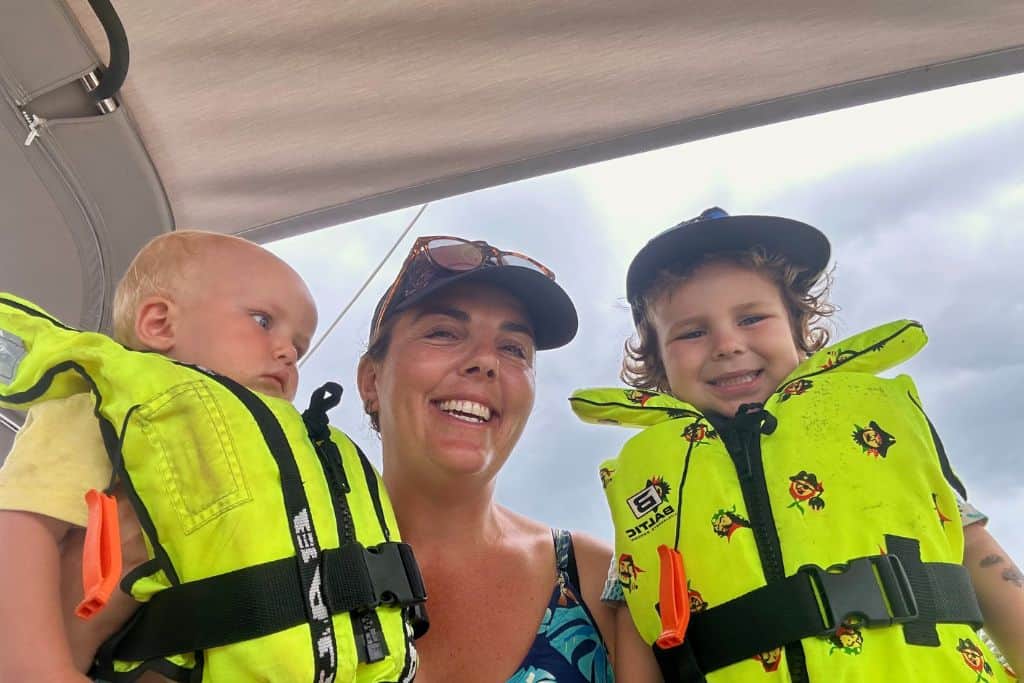
This is definitely a no-brainer because kids tend to be a bit reckless and clumsy. You’ll want to make sure that every child or baby onboard has personal age and weight related, quality life jacket. If you’re looking for recommendations then Cam has always had a Baltic brand of life jacket. And is especially pleased with his latest infant life jacket that has pirates on it!
You’ll need to decide on your own set of rules when it comes to when you expect life jackets to be worn. Some parents want their babies and young children to wear them whenever they’re on deck (sailing or not). And some like ourselves only require them to be worn when the boat is under sail. Realistically, we’re based in Antigua and wearing a baby lifejacket all day long would be uncomfortable.
If yours are walking then you may want to buy a tether for them that connects their life jacket to lifelines or a strong point of the boat. A tether ensures that they can’t walk overboard if you accidentally take your eyes off of them for even a second!
A baby carrier
One of our best tips is to buy a quality baby sling or child carrier because there will be lots of times that your baby will be crying or need a cuddle. And at the same time, you’ll need both hands free. Such as taking the helm, or working a line.
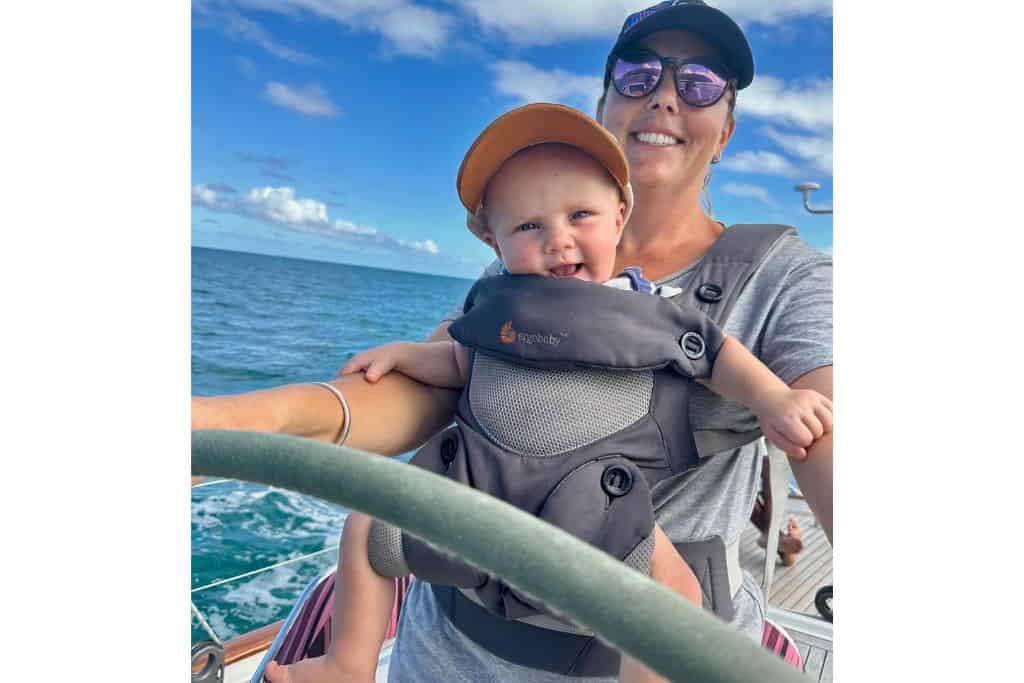
It means that you can easily have your baby on you whilst doing essential tasks as they’ll be comfortable in their baby carrier! If you’re sailing short handed then you may really need your hands-free on deck to keep yourselves safe. It’s good to know that you can support with the sailing and not have to decide between sailing and caring for your child is a massive comfort!
We use (and love) the Ergo Baby carrier as we’re massive fans of baby wearing.
Car seat for passages
You might need a secure place for your baby as you’re sailing. Or, maybe when the ocean rolls isn’t all that pleasant or the weather is bad.
We know that lots of families like to have a car seat that is attached to a secure place in the boat. It’s not something that we’ve done ourselves, but we’ve heard it’s worked well for other families. You probably won’t choose to leave them in there for long. However, it will be a place that you know will be secure if you both need to be on the deck and can’t have them in a carrier.
Baby first aid kit
As a new parent, you will want to ensure the first aid kit you have is stocked before you head off sailing with a baby! We always make sure to be stocked up on baby paracetamol and ibuprofen, plus when the boys are teething we take teeth powders.
Even if you’re only sailing from shore a couple of hours it’s just as important to carry the basics in case you need them. You should check that all of the medication is still in date and kept safely away from small hands.
This is a good guide and includes extras things to think about such as a baby safe pain relief and a guide to baby first aid.
For longer passages offshore then before you go it’s worth speaking to your doctor. They might suggest taking an emergency supply of antibiotics. Or maybe other things you can’t buy over the counter in case of an emergency at sea.
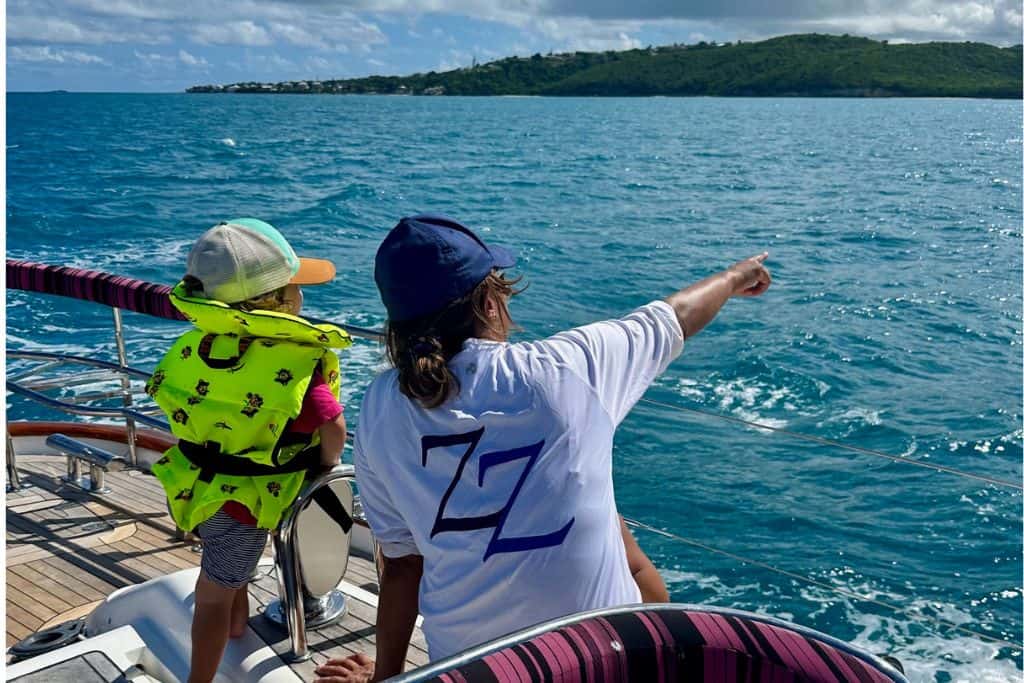
Netting around the side of the boat
When your baby starts moving then you’ll possibly want to think about putting safety netting on the lifelines around your boat. They will help to contain them and will give you a preventative measure in place just in case they decide to start climbing overboard.
Obviously, this isn’t totally foolproof, however, extra safety measures will help you to worry less.
Because Carl works on private yachts we don’t have a chance to put nets on the railing. That’s because the boats aren’t ours to adapt. Instead, we have special rules with Cameron on where he’s allowed to go on the yacht and when. This has worked well for us so far, however, we never let him out of our view.
Weather protective wear
Getting exposed to all the different weather you’ll have when you’re sailing might be a cause for concern for adults, and will be for young children too. Upset from cold rainy days can easily be prevented by ensuring everyone has the right clothing for the weather.
You should ensure you have plenty of sun protection for all kids, including sunglasses, SPF-rated clothing, and a hat. You’ll want suncream with a high SPF that’s suitable for young kids and their delicate skin. We always focus on making sure that the boys are protected and hydrated as sun exposure with younger kids would be awful.
You should also ensure you have good cold-weather clothing and waterproof gear in case there is a change in the weather. We’d also recommend having a good sleeping bag on board to warm you up for if the temperature drops!
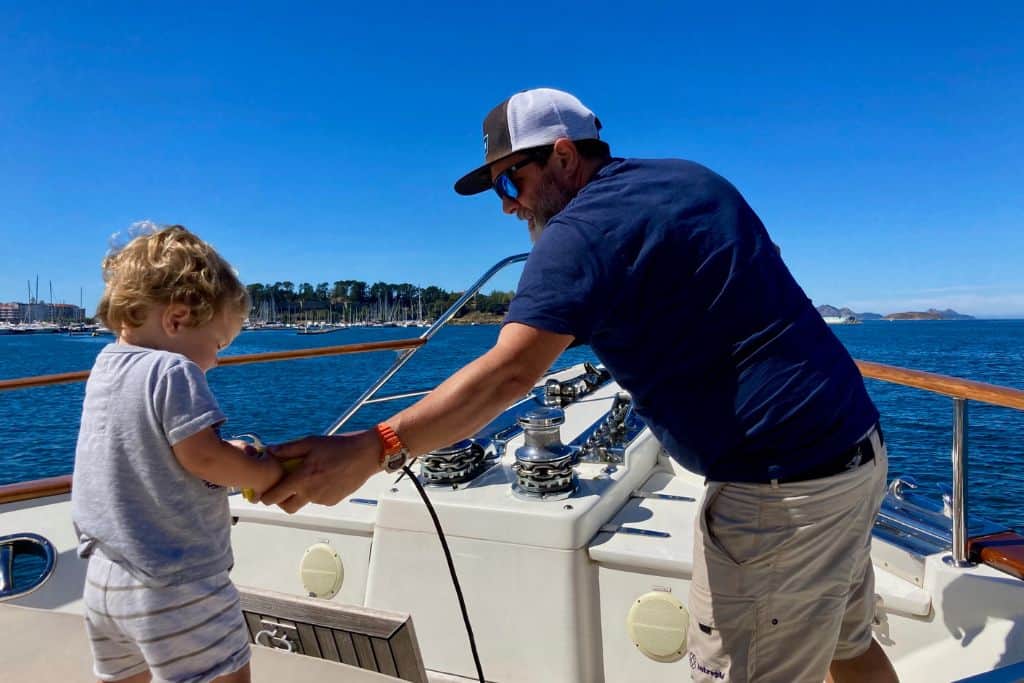
Passage planning tips for sailing with a baby
For your first time sailing with a baby you may want to think ahead a bit more when passage planning. Especially for the first couple of sailing trips that you take. It’s a good idea to try out some cruising grounds that you are familiar with for a little while. A sort of dry run, until you’re happy with the new setup onboard. Then you have a chance to make adjustments to your set-up before you head off for longer passages. We’ve not done any long passages or offshore sailing. Which means we’ve never needed to panic if thanks aren’t quite going the way you planned. Because we could just nip ashore to sort it out.
A checklist for sailing with a baby
We put together a checklist of things that you’ll want to consider. It covers what we’ve already spoken about along with some other items you’ll need to consider having onboard before heading off on your first sailing trip with a baby. The type of boat you have might also affect what space you have for baby gear. With this in mind, we’ve tried to recommend options that fold away for great storage.
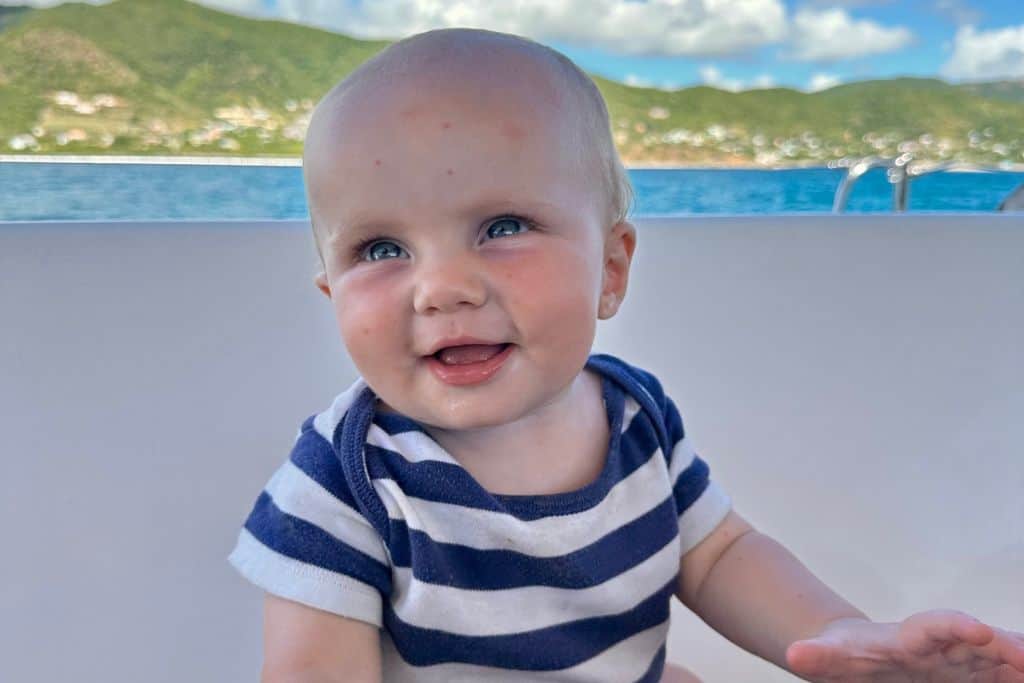
1. Lifejacket
As we already mentioned, a decent infant lifejacket for any children or babies onboard is essential.
2. Tether
You may want to have a tether on your child’s life jacket if they’re moving around. That way they’ll safely kept within the cockpit as you sail along! You’ll want to buy one that is specifically designed for kids and that won’t stretch.
For newborns having a tether isn’t so important because they aren’t on the move – yet!
3. A secure place for them to go when sailing
This depends on your baby and the boat you have. However, as we mentioned earlier you’re probably going to need a place to securely leave your baby. Just in case you need to give your full attention on deck.
It will need to be a secure place for when the boat rolls, an example being a car seat attached to some seating, which seems to be the ideal amongst sailing families. They’re trusted because they are designed to keep your baby safe in case of a car crash.
We prefer to have our baby on us in a baby carrier. However, we totally appreciate that if the boat starts to roll then you might not feel stable yourself. This is why it could be handy to have a car seat in place as a just in case!
4. A plan for sleeping
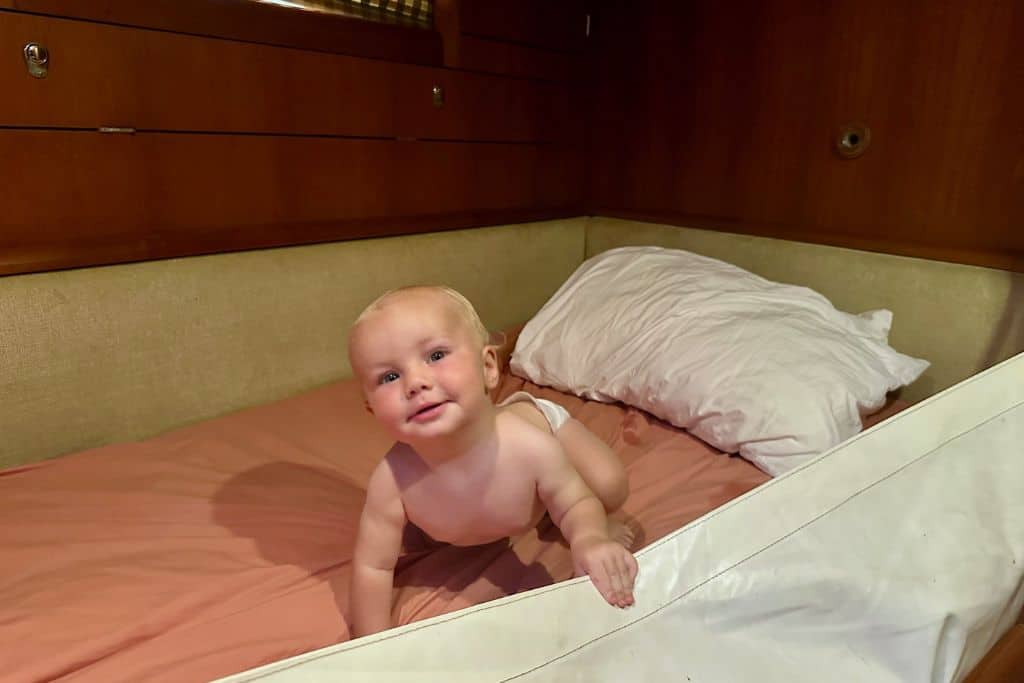
In a land based based bedroom you’re likely to have plenty of space for an actual cot. However, in a boat you’re unlikely to have space for one (unless you’re in a super yacht!). This means that you’ll need to be a bit flexible on where your baby sleeps. There are a few options that we can recommend for sleeping arrangements.
We appreciate that sleeping is personal preference in the end and hopefully one of these solutions will fit for you!
Travel crib / cot
One option is to put a travel cot on one of your beds. You can either choose to sleep beside them for instance on one side of a v-birth. Or, you can sleep in a separate cabin. These will stand well on a range of surfaces, and are usually smaller and more lightweight than a proper cot. We’ve use a BabyBjorn one before that we think is great. It’s very lightweight and can easily be strapped into place.
Moses Basket or sleep nest
Whilst your baby is still small you could decide to use a Moses basket. They’re a lot smaller than a cot, however, your baby will probably outgrow it pretty quickly. We’ve had a sleep nest that has been handy for Dylan’s nap time as it can be brought up to the cockpit. You still need to watch them, it just gives them somewhere comfortable for a short sleep.
Co-sleeping
Some parents might choose to co-sleep with their children for various reasons, however, it’s important to read up on the safety guidelines before you do.
For us, co-sleeping on a boat has been one of the best options. We pop Dylan down to sleep and then tie up the leecloth. We can then carry on with our evening and I can head to sleep when I’m ready. When we’re not on a boat he spends the first part of the night in a travel cot at home. This helps him to be used to both ways of sleeping.
We can’t emphasise enough, that it you do decide to co-sleep that you please make sure you’re doing it as safely as possible and consider all the guidelines. That might mean no sundowners before bed!
Bed divider
Another clever trick that we thought about doing, and have heard that others do, is the bed divider. You can use the divider in the double bed (if you have one) so you’re kind of co-sleeping but with something in between you and the baby. It’s still worth reading up on the co-sleeping guidelines if you decide you’re going to do this. And also checking that things like your mattress are suitable for a baby.
5. A baby carrier
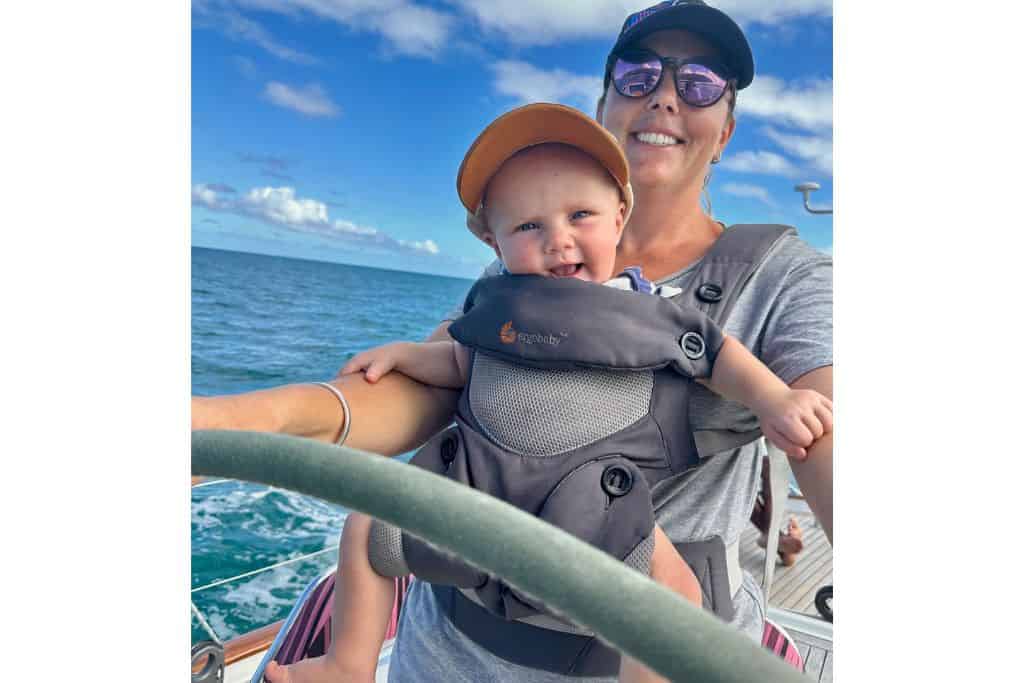
Another safety essential that we mentioned earlier, which is ideal if you need to have two hands available for tasks sure as helming or docking. We use the Ergo Baby carrier and have in the past used Baby Bjorn as well. It’s worth checking out these two brands to find one that fits comfortably.
6. Compact stroller or pram
Having a compact pram onboard is indispensable for shopping or for walking around town. If you’re provisioning and are carrying your baby in the carrier on your back or front then you perhaps can’t carry as much shopping. What we love about having a pram is that you can use it like a trolley and load it with shopping for the walk back. Plus carry a backpack for when you need a larger shop.
There are lots to choose from out there. There are some great ones that fold up incredibly well for storage in the plane overhead lockers.
7. Baby first aid kit
As we mentioned earlier, first aid kit stocked up with supplies for your baby is a safety essential.
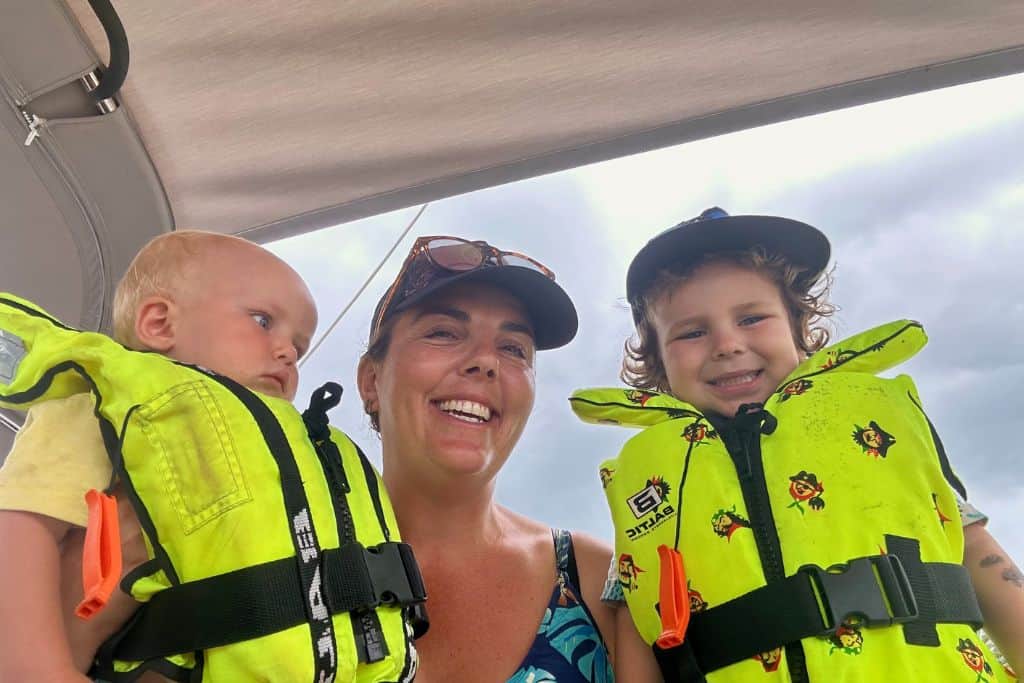
8. A way to feed them
It seems obvious, however, you’re going to need to consider how you’re going to feed your baby while you’re on the boat!
If you’re breastfeeding then this might not be too tricky. However, if you’re using formula then you’ll have a few things to consider. Such as whether you can get your preferred formula milk in the country you’re cruising. And how you’re going to sterilise the bottles. I’ve breastfed both both of my boys, and then moved on to adding formula into the mix later down the line. In Antigua they don’t stock our preferred formula. So I’ve had to bring out formula in bulk for the boys. I’ve even had friends bring it out when they visit.
9. High chair
If you’e staying onboard with either a toddler baby then eventually a high chair once they are able to sit up will become a must. It’s unlikely you’ll have floor space available for a normal high chair with four legs. A great option is to use a clip on high chair that attaches onto the table. Or one that straps onto a chair. This one is great as it’s a stand alone baby seat, so you can also take it to another boat or the beach.
10. Bib
The less cleaning you need to do onboard the boat the better it is! It’s already a small space to try to keep clutter-free and tidy and there’s also the added complexity that there’s usually a limit on the water supply on board.
We usually (because it’s sunny where we’ve been) strip the boys down to their nappies when we feed them. And then add on a simple silicon bib to catch any food that doesn’t make it into their mouths.
This will help reduce the amount of washing you need to do. Because you’ll want to keep the number of washing loads down to save electricity and water.
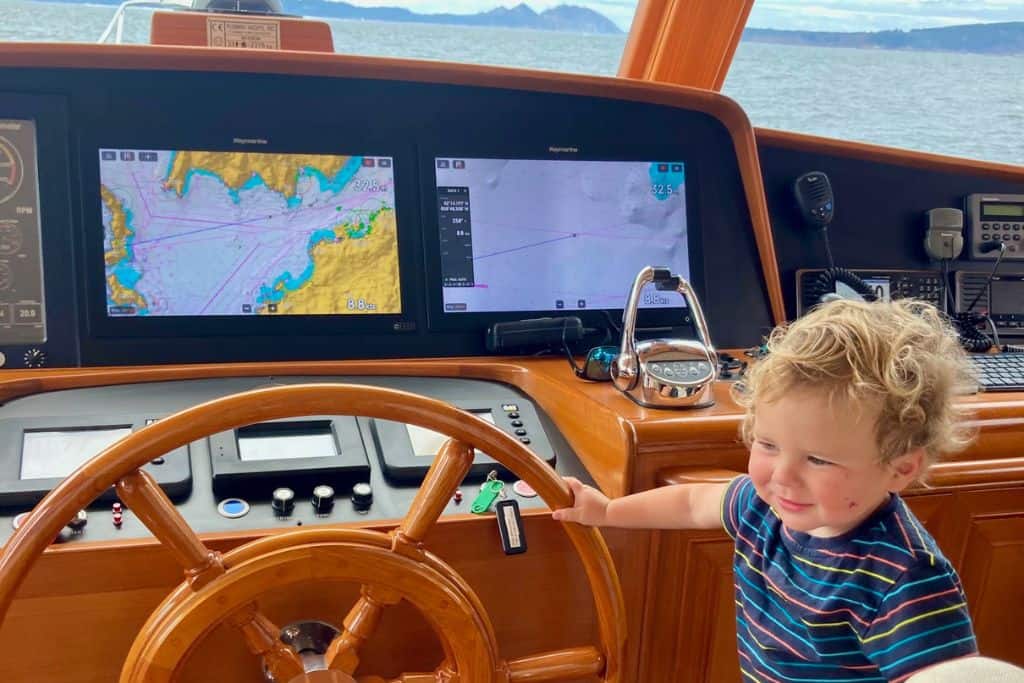
11. Wipes and nappies
One of your first decisions as a new parent will be deciding between reusable and disposable nappies. We loved the idea of reusable ones as they’re more environmentally friendly. However, we sadly decided that the additional workload and practicality of cleaning them wouldn’t work for us. If you’re using reusable nappies then it does make things easier as you won’t need to restock them.
With disposable nappies you’ll have to choose a brand that works for you. We’ve always used supermarket own brands to keep the costs down. However, in some countries you’ll find it impossible to buy affordable nappies. In Antigua the cost of living is so much higher and the price of nappies is ten times higher than in the UK. We take in extra luggage over with us packed with nappies and wipes as it saves us money in the long run.
As well as your choice of nappies, you’ll need to get yourself a good supply of the wipes which work the best for your baby.
12. A changing mat
If you’re on a short sailing trip then a compact travel change mat is fantastic for onboard because it doesn’t take up much space on your boat. The great thing is that you’ll also use it when you are onshore for trips.
If you’re living on board then you might want to also buy a more permanent one for the boat that can be cleaned easily and live in one spot. We have a simple one that we’ve bought from a supermarket that we can use on the bed.
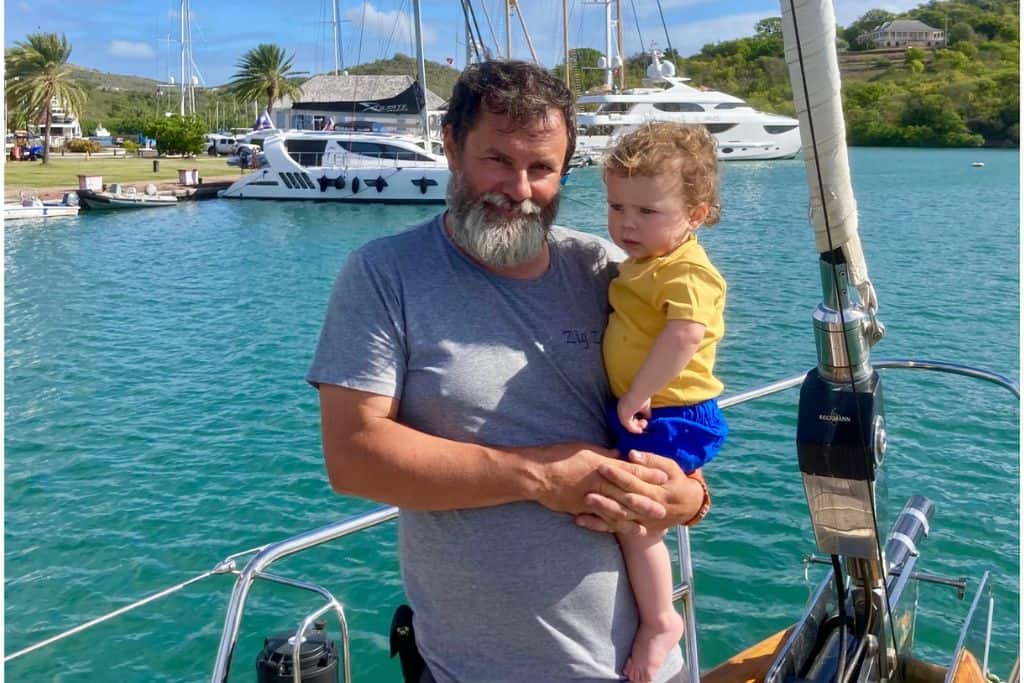
13. A changing bag for sailing with a baby
This is an essential when you’re a new parent trying to get out of the house with a baby. We’ve had our same changing bag for 3 years since Cameron was a baby. Having a dedicated baby changing bag that’s packed with all the of your essentials will help you be ready to head ashore without fussing to pack things. Ours slips easily into one of our dry bags so that we can slip it in for rainy days or rainy tender rides. It’s worth making sure that yours does too, as nothing worse than going to grab some spare baby clothes and they’re wet because the bag is wet. We’ve had that happen before!
Luckily baby changing bags are quite stylish these days! Our is a Storksak bag, and has really weathered the test of time really well.
14. Muslins and more spare muslins
Muslins are extremely useful for almost everything and anything, so you’ll want to have a big supply on board. Great for cleaning things such as baby or you when they’ve been sick, however, they’re also great for covering you and baby up. I use them loads as a modesty covering when I’m breastfeeding. Though I have to admit half the time I don’t bother. They also make great towels.
We wouldn’t necessarily say that you need to head out and buy any in advance. In our experience, lots of people will gift them to you when a baby is born.
15. Clothes
If you’re just out for the day on a short sailing trip then you should have a reasonably reliable forecast. However, we all know just how quickly the weather can change once you’re out sailing on the water!)
There are some essentials you’ll need when sailing with a baby, to help we’ve put a short list.
- Under layers such as baby grows
- Sun hat
- SPF rated sun outfit
- Swimwear
- Warmer outfits such as long sleeve baby grows, trousers, jumpers,
- A warm pram suit or even a sleeping bag just in case it becomes colder and windy
- A waterproof, your pram suit might be waterproof
16. A baby tent
Our friend has this incredible baby tent. She can pop it up on the boat and put her son in it, knowing that he’s going anywhere. It’s also got a shade on it and mossie protection.
The tent is also perfect for heading to the beach with or for nap time outdoors because it’s got a full shade cover, and great security!
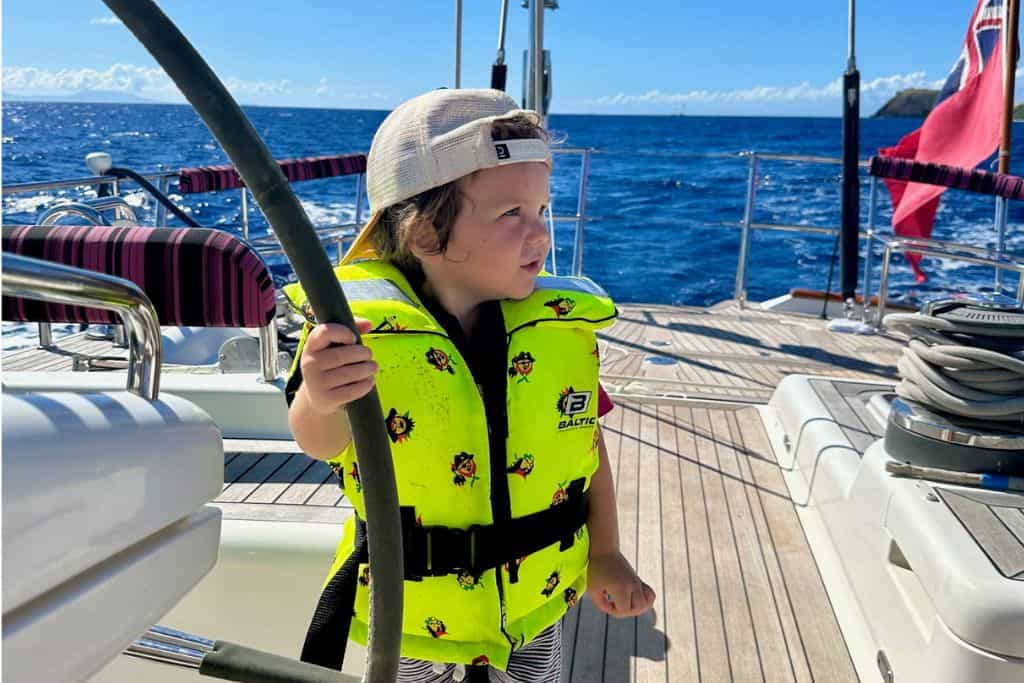
17. Sleeping bag
A baby sleeping bag is a fantastic way to keep your baby warm during the night when you’re onboard. We’d suggest choosing one that’s suitable for the climate of where you’re sailing. For Antigua we have one that is just a piece of cotton because each one has a slightly different tog.
Sleeping bags are great because if they’re sized correctly they can’t ride up and go over your babies face like a blanket might. Which makes them a lot safer. We love them as it gives Dylan the cue that it’s bedtime when we slip him into it. And even today, Cameron still uses one when we go camping as he has one with separate legs. Sleeping bags are good to have with you in case there’s a temperature drop and you have to warm up your baby.
If you’re living onboard you’ll probably want to have two in case your baby gets sick on it in sick, or has a poo explosion in it.
18. Blankets
Blankets are great for trips onshore or for colder nights when you need some extra warmth keep your baby snug. We always have a few available board that we use to wrap up Dylan while out sailing in case the weather gets cooler, or to use as extra layers during the night.
We’d recommend always picking cellular blankets because these are with all the little holes in so if they do happen to ride up they’re a lot more breathable.
19. Dummies and teethers
We never had much luck with dummies with either boys, however, we can totally see the benefit to them. If you think that you might need some, then you’ll need to make sure you have a them stocked up as we know of friends who’ve not been able to find them in certain countries. Instead they’ve had to get friends to bring them out when they visit.
The same can be said for teethers. We really struggled to find any in Antigua and instead a friend of ours helped us out by giving us one that her son wasn’t using anymore.
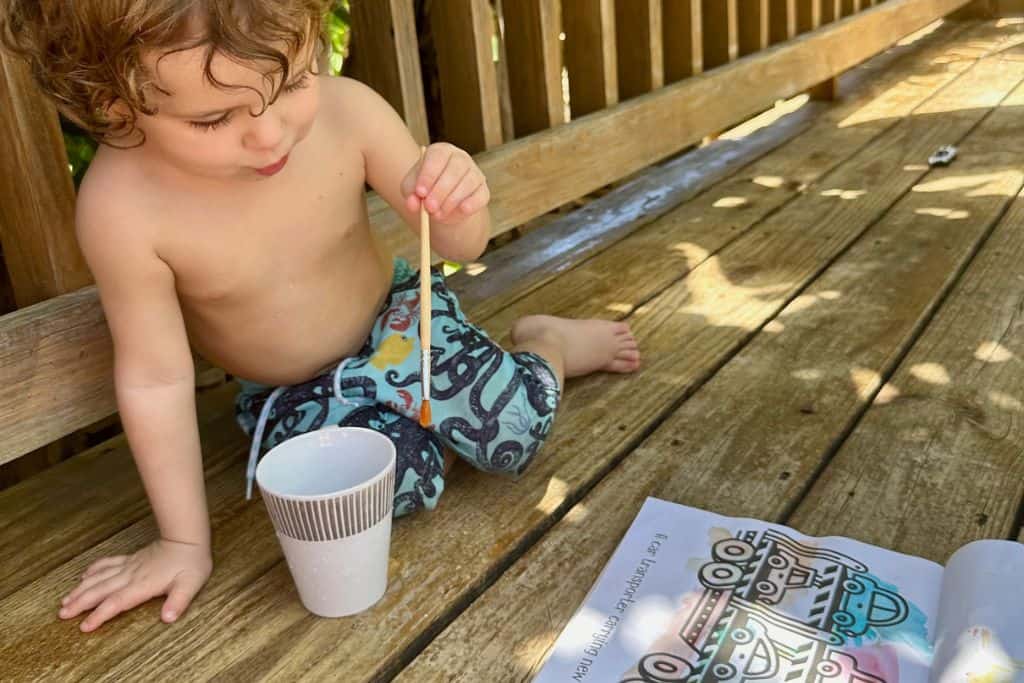
20. A place to wash your baby when you’re sailing with them
You’ll need somewhere or something to wash your baby in. A sink can work well for when your baby is very little, however, as they get bigger you’re going to need a bigger place pretty quickly!
You can get foldable baby baths or ones that inflate, which are ideal because you may not have much storage space onboard to store a full sized one. We’re probably a bit unusual, but we take Dylan into the shower with us. Even at home in the UK we’ve never had a full sized baby bath or an actual bath to use. We just hold him in our arms as we gently wash him, they can get slippy.
21. Entertainment and toys
You probably may not have as much storage for the usual stash of baby toys that kids seem have these days. You’ll maybe choose a small selection of age appropriate toys to have onboard to help keep them happy and entertained. However, don’t forget that babies will find different ways to play with things you already have onboard too, Dylan loves the noise of scrunching up empty packaging of any sort
We find that sticker books bring lots of fun for Cameron. He also has his own Trunki which is where he has to keep all of his toys, and we get him to choose what to bring before we leave home.
If you’re living onboard then other local cruising families are usually up for swapping books and toys so you have a new supply of entertainment!
22. Baby bouncer
This is a bit of a game changer, as it means that you can pop baby somewhere safe inside whilst you do tasks such as cooking. Especially when they get to the age where they can’t quite sit up on their own, but still want to be sat watching you. We loved ours, as its super flexible and because baby is strapped in, you don’t need to worry about them falling out. When you are finished it can be easily folded down for storage.
23. Baby monitor
We always take a baby monitor with us wherever we travel. It means that we can pop the boys to bed without having to worry whilst we head up onto deck to enjoy our evening. We have used a couple of different options, you can get a physical monitor system which the parent and child parts. However, we’ve also found it helpful using ones that connect through our phones to a tablet that we leave in the bedroom rather than needing a physical one.
FAQ’s about sailing with a baby
Did you know that some babies are born on boats? There isn’t a universally specified minimum age, it’s usually suggested to wait until a baby is a few months old before going sailing with them. This gives both the baby and mum time to recover from the birth, and to make sure that there aren’t any medical issues to be aware of.
The age at which you decide to take your baby on a boat may vary depending on several factors. These could include local regulations and the specific circumstances of the boat trip, for example you may not want to just straight into an ocean passage. The main thing is that safety is a crucial consideration when taking a baby on a boat.
For your first time, you’ll probably want to try sailing with your baby in the relative safety of a marina, where the motion will be less in case they have sea sickness.
And you should always make sure that your baby is large enough to wear the appropriate size of infant life jacket.
Yes, babies can sometimes experience seasickness, in the same way we adults can. Babies and younger children can be more likely to have motion or sea sickness. This is because their vestibular systems which is responsible for their balance and spatial orientation are not fully developed. Both our boys and Carl suffer from sea sickness – yes professional sailors can suffer from it too! Dylan seems to have escaped it so far (crossed fingers!).
If you’re worried about seasickness, then here are some tips that could help:
1. Choose the right yacht: A bigger boat or a catamaran because they are more stable and have minimal rocking motion.
2. Stay in the middle of the boat: Being in the centre can reduce the sensation of the motion compared to the back or front.
3. Plenty of fresh air: Ensure proper ventilation inside as stuffy environments can enhance nausea.
4. Distraction: Get your baby enjoying fun activities to take their attention away from the motion.
There are a lot of differing guidelines, some suggest waiting until your baby is over 2 months old before the go swimming, and others advise waiting until they’re 6 months. Both of our boys have been in the sea and swimming pools since they were weeks old. One thing that we do, is make sure that they don’t inhale too much water (as some is always inevitable with young kids!). Particularly sea water which is high in salt, and young kids can’t process salt intake the way that we can as adults.
Whenever you decide to take them for their first swim, please remember that they won’t be able regulate their body temperature the way we can. Therefore, it’s very important they don’t get cold. We have these fun baby wetsuits that we used for both boys.
Also, currents may might make it difficult to keep hold of your baby which is why we’d recommend sticking to shallower waters so that you can easily stand and support them.
Final thoughts on sailing with a baby
Sailing is one of the most amazing things we’ve done as a whole family. It’s possible to have so much fun, whether it’s a full time live onboard lifestyle or a sailing holiday. The main thing that you’ll need to do, is to prepare the boat for the baby to come onboard. You’ll want to ensure that the baby is safe, such as having an infant lifejacket.
Once you have the safety aspects covered you can relax a bit more an enjoy your time on your sailing trip. If you’re unsure, then a day sail is a great way to have a trial of sailing with a baby.
